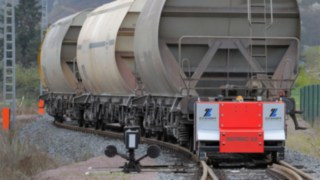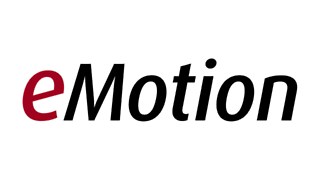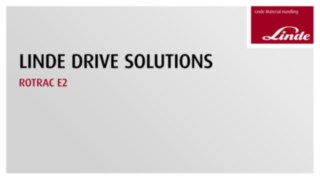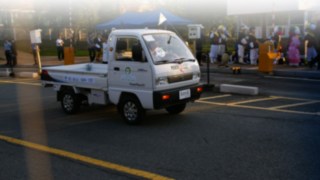ROTRAC E2 and E4 by Zwiehoff with Linde electric drive technology
21st Century Railroad Cars
Up to 500 Tonnes in Tow
When you think of railroad cars, the first thing that comes to mind is historical vehicles from the pioneering days of the railroad. However, they are an indispensable tool in modern rail transport. They are used when rail cars and wagons have to be maneuvered in loading yards, car washes or workshops, because this requires extremely strong and flexible tractors. Compared to their historical predecessors, these are not moved by hand, but by a powerful 21st century motor.
The idea was conceived by
rail/road specialist Zwiehoff
who then commissioned Linde eMotion to equip the vehicles ROTRAC E2 and E4 with electric drives. No sooner said than done: The proven forklift technology from Linde Material Handling was integrated directly into the rail/road shunters. As ‘rail/road’ shunters, the vehicles drive just as well on the road as they do on rails. The compact and efficient solution even impressed a specialist jury, with the two vehicles winning the 2013 industry prize thanks to their excellent technological, cost-effective and ecological utility value.
For the development, we were looking for a partner not only to provide high-quality components as standard, but also one with many years of experience in the electromobility sector.
Stephan Zwiehoff, Managing Director, G. Zwiehoff GmbH

Emission-Free Power Packages
Based on specifications provided by Zwiehoff, Linde eMotion first developed the ROTRAC E2. The entirety of the electric drive technology and components was taken from Linde’s series production – starting with the two electromechanical drive axles, through to the inverter and the charging connection, and finally the control. This resulted in a previously unheard-of vehicle concept. The performance is astounding: The extremely compact vehicle can tow up to 250 tonnes.
3.5 tonnes less diesel
Electric shunters protect the environment and reduce energy costs. A diesel-powered shunting locomotive consumes 20 liters during preheating and as much as 150 liters per hour in shunting operations. In total, the ROTRAC saves around 3.5 tonnes of fuel per day.
The successor model, the ROTRAC E4, is based on the ROTRAC E2. Thanks to its high-performance forklift components, it is able to tow double the load of its predecessor with up to 500 tonnes. Both vehicles operate completely emission-free thanks to their electric motors. The production was managed by Linde’s subsidiary Proplan.
Easy and Efficient Handling
The vehicles are easy to steer with remote control. This allows the operator to walk alongside the vehicle, stand on a step or travel within the towed rail vehicle. An especially convenient feature is that the truck can drive outside of the rails in the event that a track change is required. An energy recovery system ensures optimum energy efficiency. The vehicles also have a boost function for smooth and fast acceleration.
Smart Design Principle
On the right track
The derailment of shunters means downtime and possibly even material damage or personal injury. There is a particular risk with elevated tracks. The ROTRAC’s readjusting pendulum axle is monitored constantly. This enables precise torque-free balancing between the rail wheels and automatically readjusts when necessary. This reduces the risk of derailment.
The design principle of the vehicles should be as simple as possible. For example, the fully synchronized independent wheel drive eliminates the need for special steering components. Instead, the tires simply turn in the opposite direction to the steering. This allows for a very small turning circle of less than one meter when maneuvering outside of tracks. The elimination of additional components also reduces the investment costs for users.
Safety in Linde with High Linde Standard
The vehicles have a lot to offer in terms of safety: high ground clearance, shunting treads and retaining brackets, a railway car brake system and automatic temperature control to protect against overheating. Another special feature is the readjusting pendulum axle, which ensures protection against derailment.
The Vehicles in Detail

ROTRAC E2
The ROTRAC E2 combines an extremely compact design with very high traction.
- Service weight: approx. 3,800 kilos
- Dimensions: approx. 2,300 x 1,800 x 1,300 mm
- Drive motors: 4 x 5.5 kW nominal power
- Battery: 48 V, 620 Ah
- Maximum tow load: 250 tonnes
- Rubber drive wheels: 500 mm
- Turning radius during road travel: 0.9 meters

ROTRAC E4
The ROTRAC E4 can tow double the weight of the ROTRAC E2.
- Service weight: approx. 7,500 kilos
- approx. 3,700 x 1,858 x 2,250 mm
- Drive motors: 4 x 12.5 kW nominal power
- Battery: 80 V, 930 Ah
- Maximum tow load: 500 tonnes
- Rubber drive wheels: 780 mm
- Turning radius during road travel: 2.5 meters
The ROTRAC in Use
One of the first companies to use the ROTRAC E2 was Deutsche Bahn. The company not only uses the vehicles for regular shunting operations at some of its sites, but also as part of a pilot project aimed at implementing fully automated rail operation in the future. In collaboration with its partners in Paderborn, the company carried out a corresponding pilot project for automated shunting. Up to now, the marking of freight wagons has always been carried out manually before they are moved by diesel locomotive onto the right track. In the future, the shunter should be fully automated and work 24/7 with the utmost precision and efficiency.










